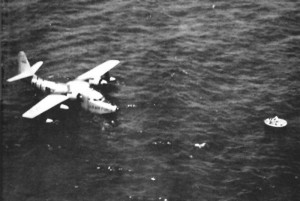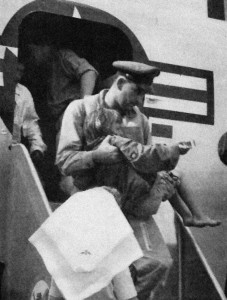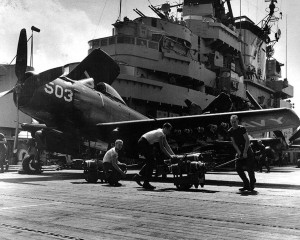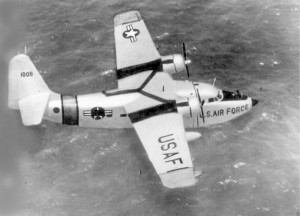
Published July 28, 2012
The Amazing Rescue
First, Captain Woodyard flew to the smoother waters on the downwind side of Tachou Tao Island, flying over a fishing village and between the two mountains on the island. He made a landing in the waters on the leeward side — even that proved to be a challenge. This put him close to the island — he wryly noted later that the Chinese seemed to ignore the entire operation, though the Chinese communist government had issued a warning that military planes would be shot down if they ventured within the 12 mile limit.
Captain Woodyard taxied his Albatross for 2.5 miles to the raft, guided by the French Privateer overhead. The waves repeatedly swept over the tops of his wings. Arriving on the scene, a line was thrown to the passengers, who were hauled on board the Albatross. Counting ten on board, Captain Woodyard recognized that he was vastly overweight for a take off, approximately 1,000 pounds over his max gross weight. Getting back airborne would be a challenge even with the Jet-Assisted-Take-Off (JATO) bottles that could be strapped to the sides of the fuselage to give the plane added speed and vertical push to help get it off the waves.

With all aboard, Captain Woodyard then taxied back to the leeward side of the island once again. The crew affixed the JATO bottles to the fuselage. One of the JATO bottle covers wouldn’t come off — just then, a radio message came that there were “Unidentified fighters approaching.” Woodyard’s crew found the strength to tear off the bottle cover and they took off in haste. The fighters turned out to by US Navy Skyraiders dispatched from the Pacific Fleet to the area to cover the flight if the Chinese attacked. Captain Woodyard took a course for Hong Kong — with severe injuries one of the survivors died en route.
Final Acts at Hainan Island
With some of the passengers and crew from the aircraft still missing, search and rescue operations continued for three days — if nothing else, it was hoped that perhaps some of the bodies might be located and recovered. On July 26, 1954, as search operations were still underway, incredibly two more Chinese PLAAF returned to the area, this time to ambush two US Navy propeller-driven search and rescue aircraft.

The USN’s SAR operation, however, was not without teeth. Admiral Felix Stump, CINC of the US Pacific Fleet, had ordered that his pilots, “be quick on the trigger” in response to any threat. The two search planes were Douglas AD Skyraiders from VF-54 flying off of the aircraft carrier USS Philippine Sea (CVA-47). Well armed and powerful, the Skyraiders were more than a match for the second pair of Chinese LA-7s, which had hoped to ambush the Navy planes. Also in the air was an F4U Corsair. Undaunted, the Navy pilots pulled their Skyraiders around into a counterattack, even as they called for assistance from the fighter jets of the combat air patrol. However, within minutes, the two Navy pilots had shot the two Chinese planes out of the sky. The kills would be shared by Navy pilots, R.M. Tatham, R. R. Crooks, and J.L. Damian.

Political Fallout
In the wake of the brutal shootdown of a civilian airliner, the Chinese government would suffer serious political consequences. Three days after the events, on the same day two of its LA-7s would be downed, the Chinese would admit of their error, but still claimed that the plane had been mistaken for a military aircraft of the Chinese Nationalists that was supposedly attacking Hainan Island. The Chinese government then reportedly ordered the execution of the two LA-7 pilots.
Given China’s open aggression, the United Nations would react harshly, disallowing China’s membership on the Security Council. Likewise, a period of intense economic isolation would also follow, only ending with Nixon’s open door policy in the 1970s. As for Captain Phil Blown, he would fly a few more years with Cathay Pacific before retiring to Australia. He would pass away in 2009 at 96 years of age. The passengers and surviving crew members of the airliner would always remember Captain Blown as a true hero.

Captain Jack Woodyard would be awarded the Distinguished Flying Cross for his actions that day in rescuing the survivors of the downed airliner. He and his crew would say that it was their finest hour.
One More Bit of Aviation History
Valerie Parish, the six year old girl who survived the shootdown, grew up, got married and had a daughter of her own. In 2009, she was contacted by the daughter of another survivor, Peggy Thorburn. The two would meet and shared their memories of that fateful day. Of Captain Blown, the two agreed that his extraordinary and heroic actions, never giving up despite the impossible odds that faced him, were the reason why they had survived. Of Captain Blown, after hearing of his death Valerie Parish would write, “If roses grow in heaven, please pick a bunch for me and lay them in his arms. And some orchids too, he loved them so. Hold him in your arms and hug him, like he did me, the scared and frightened child of so long ago.”

What these incidents in 1954 and 2001 show is that China is being spied on by the West, especially the US. The 1954 Cathay Pacific aircraft could have been a spy plane. You never know.
In the 2001 incident, a Chinese pilot died, and in the aftermath, one US congressman described the Chinese as air pirates. But the other side is that why is the US plane in Chinese air space or loitering near China? The US is far away from China. If the aircraft was not snooping, then what was it doing there?
What will US forces do if a PLA plane were to be lurking off California?
What this shows is China must be strong and not be pushed round by the US. The PLA of 2013 is a far different outfit from what it was when it tangled with US forces in Korea 60 years ago. Today, the engagement would be different from any the US has encountered so far. US forces are used to hunting the enemy yet could find themselves locked on by PLA radars. That is a fact of life from now on.
The USAF and USN have intercepted and escorted hundreds of foreign spy planes, most of them Russian. This practice, which dates from the era of the Cold War, continues to this day. Flying ELINT missions in international airspace off the coast of foreign countries is routine practice dating back prior to World War II. Such flights continue unabated to this day.
It is worth noting that not all flights are reconnaissance. In recent months, Russian Tu-54 Bear bombers have repatedly flown near US bases, ships and territory while armed with nuclear-tipped cruise missiles that were visible on the wings. In one such case, a Russian nuclear-armed bomber orbited the burgeoning Pacific base at Guam so as to demonstrate their reach.
Yet despite this routine ELINT, which is universally declared to be legal, it is seemingly only China that seems to respond with aggressive posturing, including the events that lead up to the midair collision off Hainan.
Many Chinese, including the commentator above, seem to feel that such aggressive tactics reflect well on China and its military strength — rather, the opposite is true. Distrust and uncertainty are the natural results and lead to souring relations. China’s spoken policy of harmony with its neighbors is more and more being shown to be little more than a farce.
If the writer is expecting that the US will react in fear, he is dead wrong — the principals of internationally free air space must be preserved, despite China’s recent attempts to extend its military control area in the South China Sea. As many countries in the region sound the alarm bell, the US has begun the military “pivot” to the Pacific, which has led to increased US influence in the region, rather than less, as China may have hoped.
I was so happy to find this story about this rescue mission. Capt. Jack T. Woodyard was my dad. He passed away too young, in 1976.
Please know I am sad to know that your Dad passed away in 1976. My mother passed away in 1975. For many years I tried to find Capt Woodyard and personally tell him how much I loved and appreciated his compassion and flying skills that saved our lives that awful day. I still remember that rescue flight
June, your Daddy, was one hell of a pilot!!!
By the way, the flight jacket of Airman Rodriguez, who was part of that amazing rescue crew, was returned to him. My Mother saw to it as we knew how much the jacket meant to him as my father was once a pilot too.
Take Care and God Bless,
-Valerie
Valerie,
I am Jack Jr., now 67. When my father died my mother and I had the sad task of going through his papers. We came across a letter from you thanking him for saving your mother’s life. It is one of my most cherished memories of my father. He never shared any of the story of his heroism with me during his life.
I hope you are well. We share a bond that I did not fully understand until reading your messages to my sister.
Jack
Dear Valerie,
I have read your account of what happened on that day and would be interested in writing to you and finding out more. My grandmother’s brother was aboard the flight.
If you are checking the messages it would be great to know and perhaps we can connect.
Kindest regards
James
In ’53 my squadron on Guam, VJ-1 transitioned from PB4Y2 Privateers to P2V Neptunes. We flew weather, SAR, and recon from japan to the Phillpines and the other islands. July 23, 1954 found my crew and our P2V-2 in Kowloon, China. That’s where this story begins:
*On 23 July 1954, after three days R&R in Hong Kong we were ordered back to Sangley Point, PI, to resume our Weather and Recon flights.
I and the rest of my P2V-2 flight crew were standing outside Kai Tak Operations watching this huge, white, four-engine seaplane, a British Short Sunderland, taxi out into the bay, turn into the wind and seas and begin to takeoff. In the process the right wing float dipped into the water trying to jerk the plane around to the right but the pilot brought the wing up and went too far as the left float then buried in the sea causing the plane to cartwheel to a stop.
As it sat there dead in the water someone from Operations ran up to us with “I daresay Yanks, could you do a SAR (search and rescue) flight for us? We’ll provide the box lunches. We seem to have lost our seaplane.”
Instead of having to wait until the “Foreign military Flights” requirement– no takeoff or landing other than between 1300 and 1600– Oh, yes and no loaded weapons allowed– we took off for Hai Nan. Upon arrival at the crash site two Chinese aircraft which we identified as Yak-9s were still in the area to our surprise until they began their pursuit curves and zoomed past us without firing. By this time our pilot had begun diving for the water and began evasive maneuvers. It wasn’t minutes it seemed before all the planes in the 7th Fleet– Banshees, Skyraiders, F6es and F9s arrived looking for a fight but the Yaks unfortunately were safe over their island by then.
Relocating the yellow life raft was a problem but we finally found it again and I dropped two Smoke Lights and two Drift Signals around them in order to assist our destroyer in finding them and he was headed our way. I never saw the Grumman Albatross that supposedly picked up the survivors but I did see the US Destroyer that was headed that way and that was what the smoke lights were for.
Having done our bit we flew on down to Sangley Point and resumed our mission. The story wound up in either Argosy or SAGA magazine. I never saw a PB4Y-2 although our P2V-2 had a twin .50 upper deck turret which I had manned and tracked one of the attacking planes before they disappeared back over the mainland when all our 7th Fleet aircraft showed up.
Don Smith